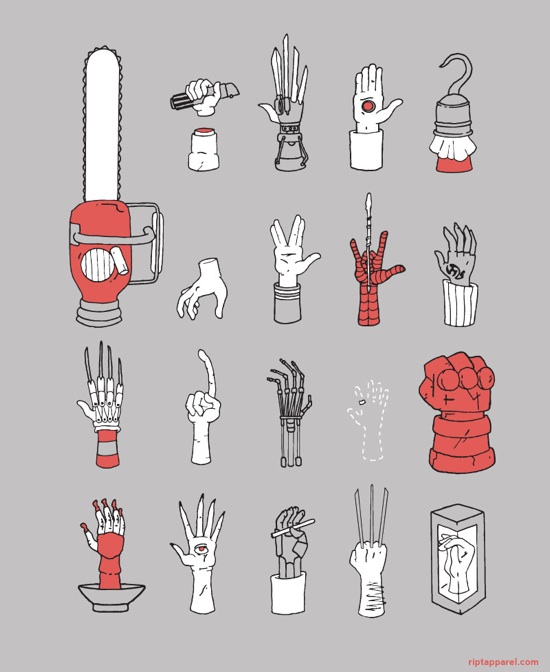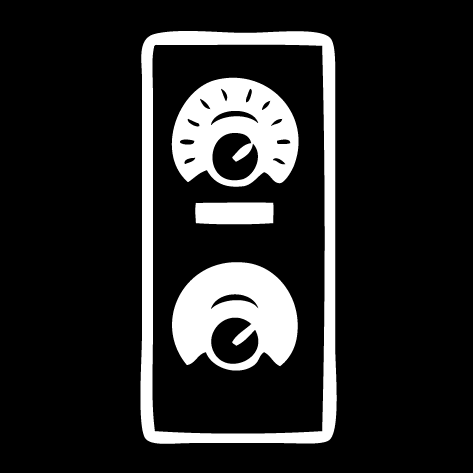tactility
Among journalists, technology breeds fear of obsolescence, corporations
On 24, Jan 2010 | One Comment | In sociology, tactility | By Dave
Another NYT article about technology anxiety, this one by Brad Stone. Some excerpts:
I’ve begun to think that my daughter’s generation will also be utterly unlike those that preceded it.
Well, it’s better to begin to think than to never start. There’s plenty of room for more people to contemplate and write about the future of technology. We are a friendly bunch! Let me be the first to welcome you, Mr. Stone.
But the newest batch of Internet users and cellphone owners will find these geo-intelligent tools to be entirely second nature, and may even come to expect all software and hardware to operate in this way. Here is where corporations can start licking their chops. My daughter and her peers will never be “off the grid.” And they may come to expect that stores will emanate discounts as they walk by them, and that friends can be tracked down anywhere.
I see, so even though technology will lift people out of poverty and make life longer and more enriching, technology is really just a vehicle for capitalist oppression. And like mad, salivating dogs, corporations will lick their chops. Right.
But the children, teenagers and young adults who are passing through this cauldron of technological change will also have a lot in common. They’ll think nothing of sharing the minutiae of their lives online, staying connected to their friends at all times, buying virtual goods, and owning one über-device that does it all. They will believe the Kindle is the same as a book. And they will all think their parents are hopelessly out of touch.
Of all the mind blowing changes that technology will bring to our society, the real thought-provoker is that those crazy young’uns will think a Kindle is the same as a book!
Mr. Stone: elevate your perspective. If you need help, read my blog, and read what I link to. Anticipate the future. Integrate it. Do develop a grounded, holistic understanding of where we’re going as a technological society. Don’t develop sociological theories based on your marvel at incremental steps like the Kindle. It won’t help you see the big picture.
“And reaching up my hand to try, I screamed to feel it touch the sky.”
On 22, Dec 2009 | No Comments | In art, language, tactility | By Dave
Check out this beautiful kinetic typography piece by Heebok Lee:
It’s based on an excerpt of the poem “Renascence” by Edna St. Vincent Millay.
- renascence
- noun
- 1. the revival of something that has been dormant.
- 2. another term for ‘renaissance.’
- (Oxford English Dictionary)
Millay, who wrote the poem when she was only 20 years old, originally called it “Renaissance.” It’s interesting that the two words are so close in meaning and are pronounced almost the same way, but they’re not considered alternate spellings of the same word.
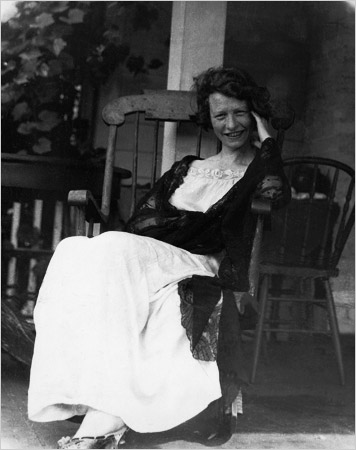 |
Click below to read the poem in its entirety. I highly recommend reading the whole thing.
Read more…
What can gardens teach us about digitality?
On 20, Dec 2009 | One Comment | In sociology, tactility | By Dave
The Washington Post has an intriguing piece about a book dealing with gardens (of all things) and digitality. The author, Robert Harrison, argues that gardens immerse us in place and time, and that digital devices do not. The article jumps all over the place, talking about mobile communication, cultural anthropology, and evolution, but it makes several important points.
To start, attending to digital devices is said to preclude being present:
“You know you have crossed the river into Cyberland when the guy coming your way has his head buried in the hand-held screen. He will knock into you unless you get out of his way, and don’t expect an apology. It’s as if you aren’t there. Maybe you’re not.”
I’m very interested in language like this, because it’s a metaphor in the process of becoming a literalism. Today, saying that you’re not there because you’re looking at a device is metaphorical, but I think that the meaning of ‘being there’ is going to change to mean where you are engaged, no matter where its geographical location is in relation to you. “I’ll be right there!” he said as he plugged his brain into the internet. Moments later he was standing in the garden…
The article quotes a study that claims that the average adult spends 8.5 hours a day visually engaged with a screen. 24-hour days, split up by 8.5 hours of screen and 8 hours of sleep—the Screen Age really does deserve its own delineation. It’s a significant and unique period in human history.
And just like sleep, perhaps disturbingly so, people looking at screens can resemble dead people (or, more accurately, un-dead people):
…We have become digital zombies.
But I think the resemblance is entirely superficial. Sure, if you only go by appearances, an army of screen-starers is a frightening sight to imagine. But scratch the surface and you realize that screen-staring is a far cry from zombism. The social spaces we are constructing while we stare, the vast data stores we are integrating—these activities remind me of life. Teeming life. Our bodies may be sedentary, our eyes fixed on a single glowing rectangle, but what is going on is indisputably amazing. On the microscopic level there are billions of electrical fluctuations per moment, both in our brains and our machines, and they are actively correlating and adapting to each other. Patterns of thought are encoded in a vast network of micro-actions and reactions that span the planet. And what is it like for you when you stare at a computer or phone screen? You juggle complex, abstract symbolic information at speeds never before achieved by human brains, and you’re also inputting—emitting—hundreds of symbols with the precise motor skills of your fingers. You are recognizing pictures and signs, searching for things, finding them, figuring stuff out, adjusting your self image, and nurturing your dreams. There is no loss of dignity or life in this. But I admit that we all look like zombies while we do it, and I suppose that is pretty weird.
The article goes on to quote author Katherine Hayles, who says she thinks humans are in a state of symbiosis with their computers:
“If every computer were to crash tomorrow, it would be catastrophic,” she says. “Millions or billions of people would die. That’s the condition of being a symbiont.”
Let that sink in. At any moment a catastrophic event could fry our entire digital infrastructure in one fell swoop. Our civilization teeters on a house of cards as high as Mount Everest! To me this is the only reason the Screen Age should be frightening, but it’s very frightening indeed.
Turning now to sensation, Hayles mentions that touch and smell are suppressed by bipedalism:
“You could say when humans started to walk upright, we lost touch with the natural world. We lost an olfactory sense of the world, but obviously bipedalism paid big dividends.”
Note that bipedalism is associated with a loss of tactility, but it has also been correlated with enabling more complex manual dexterity. Maybe there is a general principle here that ambient tactile awareness is inversely correlated to prehension.
After a brief ensuing discussion of dualism and the advent of location-based services, we’re back to the gardens:
The difficulty, Harrison argues, is that we are losing something profoundly human, the capacity to connect deeply to our environments… “For the gardens to become fully visible in space, they require a temporal horizon that the age makes less and less room for.”
I like the point about a gardens’ time horizon. But it’s used to complain about the discomfort of our rushed lifestyle, which I would argue is separable from communication technology. The heads-buried-in-screens thing doesn’t really affect whether we have time for gardens.
An interesting footnote offered by Harrison is that the Czech playwright Karel Capek, who invented the word ‘robot,’ was a gardener.
Finally, this is the photo that accompanies the article:
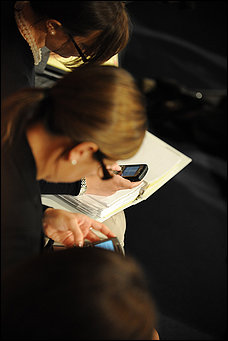
…captioned, “Fingers on the political pulse.” The article is about looking and being present, but the picture is about hands, heatbeat, and hapticity.
(via Althouse)
A touch saves a life
On 21, Nov 2009 | No Comments | In tactility | By Dave
The Moth is a stand-up storytelling podcast I’ve been enjoying lately. An especially moving story was told by Mike Destefano. When he had reached the rock bottom of his life, having lost his wife, his father, and his will to live, a mentor literally reaches out to him, touches him, and changes everything:
The flame that I had as a kid, all of it, gone. Because now everyone died. All at that one moment, you know? And I made arrangements to fly home the next day, and I got on the plane, and when I got on the plane I decided that I was going to end my life. I’m pretty much done. And I wasn’t telling anyone, it wasn’t a threat, it was a total fucking decision that I’ve pretty much had enough of this. There is no more, nothing else to live for, and I’m done. So I got on the plane, and I was so excited because I’m like, I’m really going to fucking die, this is so great! I was thrilled and at peace. And I couldn’t wait until the funeral was over, because that’s when I’m going to do it. I’m not going to jump off a building or in front of a car. You people ever heard of overdosing on drugs? …I get up and go to the back of the plane to go to the bathroom and… the monk that I had met was sitting in the back row… And he put his hands out like he did before, again… and it worked for me… it just, it worked. And I got home, and I quit my job and I said, you know what? I want to be a fucking comedian.
Listen to the whole thing.
Audio clip: Adobe Flash Player (version 9 or above) is required to play this audio clip. Download the latest version here. You also need to have JavaScript enabled in your browser.
Download (mp3, 17 MB)
Touch the paintings in the Met
On 07, Oct 2009 | No Comments | In art, tactility | By David Birnbaum
Hoping to boost attendance and broaden its base of supporters, the Metropolitan Museum of Art launched a new initiative this week that allows patrons, for the first time ever, to prod and scratch at the classic paintings in its revered collection.
…
“You can’t grasp the brilliance of a great painting just by looking at it… To truly appreciate fine art, you need to be able to run your fingers over its surface and explore its range of textures.”
…
The new policy has been so popular that on Monday the Met began extending tactile privileges beyond its paintings. Patrons are now invited to climb inside ancient Egyptian sarcophagi, whether to take a souvenir photo or just carve a message into a 2,500-year-old sacred coffin.
…
Some, however, remained unimpressed.“I touched a crapload of Jasper Johns’ paintings,” said Mark Bennet, 67. “I just don’t get why they’re supposed to be so special. They feel like any regular old painting.”
Stop crying and cursing! It’s an Onion article.
"The technical name was Perimeter, but some called it Mertvaya Ruka, Dead Hand."
On 25, Sep 2009 | No Comments | In tactility | By David Birnbaum
Somewhat tangential, I know, but I just couldn’t resist posting the image accompanying the article:

Telepresence: a good excuse to stay on Earth?
On 05, Sep 2009 | 3 Comments | In robotics, tactility | By David Birnbaum
In the New York Times, an article that cites the beautiful dream of telepresence to squash the equally beautiful dream of space colonization. Lame.
Printed strain sensors = "sense of touch"
On 14, Aug 2009 | No Comments | In robotics, tactility | By David Birnbaum
“One component in this tactile capability is a strain gauge,” says Marcus Maiwald…“If the robot encounters an obstacle,” he explains, “the strain gauge is distorted and the electrical resistance changes. The special feature of our strain gauge is that it is not glued but printed on – which means we can apply the sensor to curved surfaces of the robot.”
The sensor system on this robot is not all that complex; strain gauges are literally a dime a dozen (or less). But the configuration of the sensors reminds us of an animal body, and that’s what intrigues us. Since the strain sensors are printed along the surface of the robot in a continuous way (rather than being attached at some specific point), we’re reminded of how touch receptors are embedded throughout the skin, bringing to mind the phrase “sense of touch.” The Roomba has a mechanical sensor that is technically similar to the ones in this new robot, but we don’t talk about the Roomba having a sense of touch because the sensor is in a discrete place. To have a sense of touch you need to be able to sense contact (almost) anywhere on the surface of the body.
Hawking on evolution and technology
On 13, Jul 2009 | No Comments | In tactility | By David Birnbaum
But what distinguishes us from our cave man ancestors is the knowledge that we have accumulated over the last ten thousand years, and particularly, Hawking points out, over the last three hundred.
“I think it is legitimate to take a broader view, and include externally transmitted information, as well as DNA, in the evolution of the human race,” Hawking said.
In the last ten thousand years the human species has been in what Hawking calls, “an external transmission phase,” where the internal record of information, handed down to succeeding generations in DNA, has not changed significantly. “But the external record, in books, and other long lasting forms of storage,” Hawking says, “has grown enormously. Some people would use the term, evolution, only for the internally transmitted genetic material, and would object to it being applied to information handed down externally. But I think that is too narrow a view. We are more than just our genes.”
I found it very interesting that the accompanying image depicts digital touch, with no caption or explanation of how it relates to the article. It’s just assumed that readers will get it: a hand reaching out and creating ripples in a fluid, digital medium demonstrates that we are more than just our genes. Doesn’t it?

The Hand
On 04, Jun 2009 | One Comment | In art, books, cognition, neuroscience, physiology, tactility | By David Birnbaum
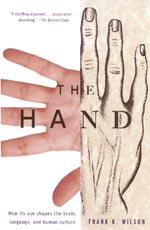 The Hand by Frank Wilson is a rare treat. It runs the gamut from anthropology (both the cultural and evolutionary varieties), to psychology, to biography. Wilson interviews an auto mechanic, a pupeteer, a surgeon, a physical therapist, a rock climber, a magician, and others—all with the goal of understanding the extent to which the human hand defines humanness.
The Hand by Frank Wilson is a rare treat. It runs the gamut from anthropology (both the cultural and evolutionary varieties), to psychology, to biography. Wilson interviews an auto mechanic, a pupeteer, a surgeon, a physical therapist, a rock climber, a magician, and others—all with the goal of understanding the extent to which the human hand defines humanness.
Wilson is a neurologist who works with musicians who have been afflicted with debilitating chronic hand pain. As he writes about his many interviews, a few themes emerge that are especially relevant to our interests here.
Incorporation
Incorporation is the phenomenon of internalizing external objects; it’s the feeling that we all get that a tool has become one with our body.
The idea of “becoming one” with a backhoe is no more exotic than the idea of a rider becoming one with a horse or a carpenter becoming one with a hammer, and this phenomenon itself may take its origin from countless monkeys who spent countless eons becoming one with tree branches. The mystical feel comes from the combination of a good mechanical marriage and something in the nervous system that can make an object external to the body feel as if it had sprouted from the hand, foot, or (rarely) some other place on the body where your skin makes contact with it…
The contexts in which this bonding occurs are so varied that there is no single word that adequately conveys either the process or the many variants of its final form. One term that might qualify is “incorporation”—bringing something into, or making it part of, the body. It is a commonplace experience, familiar to anyone who has ever played a musical instrument, eaten with a fork or chopsticks, ridden a bicycle, or driven a car. (p. 63)
Projection
Projection is the ability to use the hand as a bridge for projecting consciousness from one location to another. (Wilson did not use the word “projection” in the book.) In some ways, projection can be seen as the opposite of incorporation. Master puppeteer Anton Bachleitner:
It takes at least three years of work to say you are a puppeteer. The most difficult job technically is to be able to feel the foot contact the floor as it actually happens. The only way to make the puppet look as though it is actually walking is by feeling what is happening through your hands. The other thing which I think you cannot really train for, but only can discover with very long practice and experience, is a change in your own vision.The best puppeteer after some years will actually see what is happening on the stage as if he himself was located in the head of the puppet, looking out through the puppet’s eyes—he must learn to be in the puppet. This is true not only in the traditional actor’s sense, but in an unusual perceptual sense. The puppeteer stands two meters above the puppet and must be able to see what is on the stage and to move from the puppet’s perspective. Moving is a special problem because of this distance, because the puppet does not move at the same time your hand does. Also, there can be several puppets on the stage at the same time, and to appear realistic they must react to each other as they would in real life. So again the puppeteer must himself be mentally on the stage and able to react as a stage actor would react. This is something I cannot explain, but it is very imprortant for a puppeteer to be able to do this. (pp. 92–93)
Serge Percelly, professional juggler:
[An act is successful] not because you put something in the act that’s really difficult, but because you put something in the act in exactly the right way—in a way that makes it more interesting, not only for me but for the audience as well. I’m just trying somehow to do the act that I would have loved to see. (p. 111)
Skill
Wilson is a musician and a doctor to musicians, so he has special insight into the neurology of musical skill—which he recognizes as special case of manual skill that involves gesture, communication, and emotion.
Musical skill provides the clearest example and the cleanest proof of the existence of a whole class of self-defined, personally distinctive motor skills with an extended training and experience base, strong ties to the individual’s emotional and cognitive development, strong communicative intent, and very high performance standards. Musical skill, in other words, is more than simply praxis, ordinary manual dexterity, or expertness in pantomime. (p. 207)
The upper-limb (or “output”) requirements for an instrumentalist are not unique either; they depend upon the possession of arms, fingers, and thumbs, specific but idiosyncratic limits on the rage of motion at the shoulder, elbow, wrist, hand, and finger joints, variable abilities to achieve repetition rates and forces with specific digital configurations in sequence at multiple contact points on a sound-making device, and so on. Peculiarities in the physical configuration and movement capabisities of the musician’s limbs can be an advantage or disadvantage but are reflected in (and in adverse cases can be overcome through) instrument design: How wide can you make the neck of a guitar? How far apart should the keys be on a piano? Where should the keys be placed on a flute—in general? and for Susan and Peter? (p. 225)
Awareness
Touch experience can be a gateway to awareness, which can in turn heal both the mind and the body. Moshe Feldenkrais invented a form of physical therapy that focuses on stimulating an awareness of touch and movement sensations in order to relieve pain.
Most people slouch, tilt, shuffle, twist, stumble, and hobble along. Why should that be? Was there something wrong with their brains? After considering what dancers and musicians go through to improve control of their movements, [Feldenkrais] guessed that people must either be ignorant of the possibilities or refuse to act on them. So they just heave themselves around, lurching from parking place to office to parking place, utterly oblivious to what they are doing, to their appearance, and even to the sensations that arise from bodily movement. He suspected that people just lose contact with their own bodies. If and when they do notice, it is because they are so stiff that they can’t get out of bed or are in so much pain that they can barely get out of a chair. Then they start noticing…
What [Feldenkrais] was doing did not seem complicated. The goal of the guided movements was not to learn how to move, in the sense of learning to do a new dance step. The goal was not to stretch ligaments or muscles. It was not to increase strength. The goal, as he saw it, was to get the messages moving again and to encourage the brain to pay attention to them. (p. 244)
And his student, Anat Baniel, on the deep psychological roots of movement disorders:
I think working with children has given me this idea, which isn’t often discussed in medicine: a lot of disease—medical disease and emotional “dis-ease”—is an outcome of a lack of full development. It’s not something we can get to just by removing a psychological block…
Of course there are problems due to traumatic events in childhood, or disease—you name it. Feldenkrais said that ideal development would happen if the child was not opposed by a force too big for its strength. When you say to a small child, “Don’t touch that, it’s dangerous!” you create such a forceful inhibition that you actually distort the child’s movement, and growth, in a certain way.
Feldenkrais taught us to look for what isn’t there. Why doesn’t movement happen in the way that it should, given gravity, given the structure of the body, given the brain? For all of us there is a sort of sphere, or range, of movement that should be possible. Some people get only five or ten percent of that sphere, and you have to ask, “What explains the difference between those who get very little and those who get a lot?” Feldenkrais said that the difference is that in the process of development, the body encountered forces that were disproportionate to what the nervous system could absorb without becoming overinhibited—or overly excited, which is a manifestation of the same thing. (p. 252)
Feldenkrais’s approach is fascinating, but there is scant discussion in Wilson’s book about the role of the therapist’s hand in this process. After all, this kind of therapy is wholly reliant on an accidental discovery: that the patient can be made aware of her own body through an external, expert hand radiating pressure and heat. How is this possible? The topic isn’t explored.
There are many, many wonderful things to learn from this book for anyone with an interest in biology, art, music, history, or sports. You can find Frank Wilson on the web at Handoc.com
3-D images play tricks on your hands
On 15, Dec 2008 | No Comments | In tactility | By David Birnbaum
New, high resolution 3-D images of Mars seem to afford haptic interaction, but don’t:
“You’d swear you could touch the terrain,” HiRISE operations manager Eric Eliason said.
Alas.
The Times on tactility
On 10, Dec 2008 | One Comment | In neuroscience, physiology, tactility | By David Birnbaum
The New York Times has published a piece on tactility and haptics. It’s pretty good, and it may inspire some readers to think more about the role touch plays in their lives. Many of the points made in the article are central to my research and my life, so a proper fisking in order. Let us begin.
Imagine you’re in a dark room, running your fingers over a smooth surface in search of a single dot the size of this period. How high do you think the dot must be for your finger pads to feel it? A hundredth of an inch above background? A thousandth?
I’m hooked. I have no idea, but I’m prepared to be surprised.
Well, take a tip from the economy and keep downsizing.
We dodge the silly reference to arrive at our answer:
Scientists have determined that the human finger is so sensitive it can detect a surface bump just one micron high. All our punctuation point need do, then, is poke above its glassy backdrop by 1/25,000th of an inch—the diameter of a bacterial cell—and our fastidious fingers can find it.
Wow! Seriously, that’s incredible. I wonder whether we can feel bacteria with our fingers in certain situations.
The human eye, by contrast, can’t resolve anything much smaller than 100 microns. No wonder we rely on touch rather than vision when confronted by a new roll of toilet paper and its Abominable Invisible Seam.
This is great—not the whimsical use of capital letters to catalog the phenomenology of toileting, but the comparison of tactile resolution to visual resolution. It’s a common misconception that touch is less precise than vision. After all, the visual processing we perform to communicate (i.e., reading and writing) can seem much more complex than touch. However vision isn’t necessarily more precise, it’s just more symbol-based, which makes it seem higher resolution because it is associated with complex concepts.
Biologically, chronologically, allegorically and delusionally, touch is the mother of all sensory systems. It is an ancient sense in evolution: even the simplest single-celled organisms can feel when something brushes up against them and will respond by nudging closer or pulling away.
I don’t understand “delusionally,” and really wonder what she means. However, it is interesting that simple animals can be said to feel by virtue of their ability to react to their environment, because it says a lot about the concept of feeling: that to feel is to be alive. Nicholas Humphrey wrote in Seeing Red, “The external world is the external world, and it is certainly useful to know what is going on out there. But let the animal never forget that the bottom line is its own bodily well-being, that I am nobody if I’m not me“.
It is the first sense aroused during a baby’s gestation and the last sense to fade at life’s culmination. Patients in a deep vegetative coma who seem otherwise lost to the world will show skin responsiveness when touched by a nurse.
The chronology of touch is crucial. As I’ve written before, touch frames experience. It sets the boundaries of your self, not only in space but also in time.
Like a mother, touch is always hovering somewhere in the perceptual background, often ignored, but indispensable to our sense of safety and sanity. “Touch is so central to what we are, to the feeling of being ourselves, that we almost cannot imagine ourselves without it,” said Chris Dijkerman, a neuropsychologist at the Helmholtz Institute of Utrecht University in the Netherlands. It’s not like vision, where you close your eyes and you don’t see anything. You can’t do that with touch. It’s always there.
Which, again, may say something about touch as a concept: that to live is to touch. Try to imagine that you would like to have the experience of “not touching anything.” You jump out of a plane, but realize that your body is being touched all over by air. You float in space (with no clothes on), and splay your limbs out so that you are sure to not even touch yourself. But sensory receptors throughout your body are still reflecting your body state—the angles of your joints, the stretch of your skin. Is it possible to conceive of a unfeeling animal?
Long neglected in favor of the sensory heavyweights of vision and hearing, the study of touch lately has been gaining new cachet among neuroscientists, who sometimes refer to it by the amiably jargony term of haptics, Greek for touch.
Haptics doesn’t mean touch. It relates to the perception and manipulation of one’s environment. And why is it amiable, because you said so?
They’re exploring the implications of recently reported tactile illusions, of people being made to feel as though they had three arms, for example, or were levitating out of their bodies, with the hope of gaining insight into how the mind works. Others are turning to haptics for more practical purposes, to build better touch screen devices and robot hands, a more well-rounded virtual life.
It’s interesting that the author assumes studying tactile illusions is impractical. In fact, we haptic interface designers use tactile illusions all the time to achieve design goals.
There’s a fair amount of research into new ways of offloading information onto our tactile sense, said Lynette Jones of the Massachusetts Institute of Technology. To have your cellphone buzzing as opposed to ringing turned out to have a lot of advantages in some situations, and the question is, where else can vibrotactile cues be applied?âFor all its antiquity and constancy, touch is not passive or primitive or stuck in its ways. It is our most active sense, our means of seizing the world and experiencing it, quite literally, first hand. Susan J. Lederman, a professor of psychology at Queen’s University in Canada, pointed out that while we can perceive something visually or acoustically from a distance and without really trying, if we want to learn about something tactilely, we must make a move. We must rub the fabric, pet the cat, squeeze the Charmin.
I doubt that Lederman actually said those words, because they’re inaccurate and Lederman is one of the leading scientists in the field. Tactile sensations do not require movement, haptic perception does. Touch is incredibly hard to talk about. To do so successfully we must be particular about terminology.
And with every touchy foray, Heisenberg’s Uncertainty Principle looms large. Contact is a two-way street, and that’s not true for vision or audition, Dr. Lederman said. If you have a soft object and you squeeze it, you change its shape. The physical world reacts back.
This is also important—the act of touching necessarily produces change in the world (and thus, the context of experience), making it, at least figuratively, a singularity, or an infinitesimal feedback loop. However, I’m quite sure the Heisenberg uncertainty principle is not involved. Maybe the author knows that. Did she mean to use a difficult concept in particle physics as a metaphor for another difficult concept in perceptual science? If so, does this make the point clearer or more complicated?
Another trait that distinguishes touch is its widespread distribution. Whereas the sensory receptors for sight, vision, smell and taste are clustered together in the head, conveniently close to the brain that interprets the fruits of their vigils, touch receptors are scattered throughout the skin and muscle tissue and must convey their signals by way of the spinal cord. There are also many distinct classes of touch-related receptors: mechanoreceptors that respond to pressure and vibrations, thermal receptors primed to sense warmth or cold, kinesthetic receptors that keep track of where our limbs are, and the dread nociceptors, or pain receptors—nerve bundles with bare endings that fire when surrounding tissue is damaged.
The signals from the various touch receptors converge on the brain and sketch out a so-called somatosensory homunculus, a highly plastic internal representation of the body. Like any map, the homunculus exaggerates some features and downplays others. Looming largest are cortical sketches of those body parts that are especially blessed with touch receptors, which means our hidden homunculus has a clownishly large face and mouth and a pair of Paul Bunyan hands.
There’s another part of the sensory homunculus that’s clownishly large. Go there!
“Our hands and fingers are the tactile equivalent of the fovea in vision,” said Dr. Dijkerman, referring to the part of the retina where cone cell density is greatest and visual acuity highest. “If you want to explore the tactile world, your hands are the tool to use.”Our hands are brilliant and can do many tasks automatically—button a shirt, fit a key in a lock, touch type for some of us, play piano for others. Dr. Lederman and her colleagues have shown that blindfolded subjects can easily recognize a wide range of common objects placed in their hands. But on some tactile tasks, touch is all thumbs. When people are given a raised line drawing of a common object, a bas-relief outline of, say, a screwdriver, they’re stumped. ‘If all we’ve got is contour information,’ Dr. Lederman said, ‘no weight, no texture, no thermal information, well, we’re very, very bad with that.’
This makes sense. If you think about it, the visual qualities of an object have little in common with sensory qualities of the same stimulus perceived through a different sensory channel. Imagine that you took a two dimensional contour of a screwdriver and mapped the X and Y values to pitch and loudness, and then listened to the contour of the screwdriver. It wouldn’t sound much like a screwdriver. In fact, I would bet that if you had someone listen to that, and then listen to silence, she would say that the silence sounded more like a screwdriver than the contour.
Touch also turns out to be easy to fool. Among the sensory tricks now being investigated is something called the Pinocchio illusion. Researchers have found that if they vibrate the tendon of the biceps, many people report feeling that their forearm is getting longer, their hand drifting ever further from their elbow. And if they are told to touch the forefinger of the vibrated arm to the tip of their nose, they feel as though their nose was lengthening, too.
I want to try this!
Some tactile illusions require the collusion of other senses. People who watch a rubber hand being stroked while the same treatment is applied to one of their own hands kept out of view quickly come to believe that the rubber prosthesis is the real thing, and will wince with pain at the sight of a hammer slamming into it. Other researchers have reported what they call the parchment-skin illusion. Subjects who rubbed their hands together while listening to high-frequency sounds described their palms as feeling exceptionally dry and papery, as though their hands must be responsible for the rasping noise they heard. Look up, little Pinocchio! Somebody’s pulling your strings.
It’s great to see that ordinary journalists are curious about tactility. The article includes many of my own talking points about touch, which is cool. Of course, the way to make someone really appreciate touch is by hugging or hitting them. Alas, writing about touch will have to do for now, until haptic technology makes its glorious arrival.
My hometown's newspaper puts those annoying quotes around the word "feel"
On 12, Nov 2008 | One Comment | In tactility | By David Birnbaum
The San Diego Union-Tribune recently published an article about haptics:
On one computer, users could “feel” the contours of a virtual rabbit.
Do users “feel” the contours of a virtual rabbit, or do they just feel them? Do we “read” text on the internet, or just read it? When we watch a movie do we “see” the actors? Harumph.
The article is about Butterfly Haptics, which is a haptic interface based on magnetic levitation. I “felt” it at SIGGRAPH ’08, and it was extraordinarily crisp and strong. The only problem is that the workspace (range of motion) is tiny compared to other haptic interfaces, and there doesn’t seem to be a clear development path for expanding the workspace using magnetic technology. Nevertheless, it’s great to be able to add magnetic field actuation to the relatively limited number of technologies that can be used for haptic display.
Philosopher deathmatch, and how words are like tools
On 07, Sep 2008 | No Comments | In books, language, tactility | By David Birnbaum
 I just finished reading Wittgenstein’s Poker. From the jacket:
I just finished reading Wittgenstein’s Poker. From the jacket:
In October 1946, philosopher Karl Popper arrived at Cambridge to lecture at a seminar hosted by his legendary colleague Ludwig Wittgenstein. It did not go well: the men began arguing, and eventually, Wittgenstein began waving a fire poker toward Popper. It lasted scarcely 10 minutes, yet the debate has turned into perhaps modern philosophy’s most contentious encounter, largely because none of the eyewitnesses could agree on what happened. Did Wittgenstein physically threaten Popper with the poker? Did Popper lie about it afterward?
The authors provide a comprehensive biographical and historical context for the incident, and use it as a springboard into the two men’s respective philosophies. It’s an enjoyable look at two self-important, short-tempered intellectuals and their rivalry.
As I mentioned in this post, I find Wittgenstein’s philosophy of language often invokes touch themes. In the following excerpt from Poker (originating from one of his lectures), Wittgenstein makes a point about a colleague’s statement, “Good is what is right to admire,” utilizing a haptic metaphor:
The definition throws no light. There are three concepts, all of them vague. Imagine three solid pieces of stone. You pick them up, fit them together and you now get a ball. What you’ve now got tells you something about the three shapes. Now consider you have three balls of soft mud or putty. Now you put the three together and mold out of them a ball. Ewing makes a soft ball out of three pieces of mud. (68)
Another example stems from Wittgenstein’s midlife change in philosophical outlook. In his first publication, the Tractatus Logicio-Philosophicus, he was preoccupied with the “picture theory of language”—the idea that sentences describe “states of affairs” that can be likened to the contents of a picture. Later, he developed a theory of language based on words as tools for conveying meaning. In my reading, he shifted from a vision-based to a haptic-based (in fact, a distinctly physical-interaction-based) understanding of how language works.
The metaphor of language as a picture is replaced by the metaphor of language as a tool. If we want to know the meaning of a term, we should not ask what it stands for: we should instead examine how it is actually used. If we do so, we will soon recognize that there is no underlying single structure. Some words, which at first glance look as if they perform similar functions, actually operate to distinct sets of rules. (229)
Here’s the relevant passage directly from Philisophical Investigations:
It is like looking into the cabin of a locomotive. We see handles all looking more or less alike. (Naturally, since they are all supposed to be handled.) But one is the handle of a crank which can be moved continuously (it regulates the opening of a valve); another is the handle of a switch, which has only two effective positions, it is either off or on; a third is the handle of a brake-lever, the harder one pulls on it, the harder it brakes; a fourth, the handle of the pump: it has an effect only so long as it is moved to and fro. (PI, I, par. 12)
Words as the physical interface to meaning. Love it!
Wittgenstein
On 28, May 2008 | One Comment | In books, tactility | By David Birnbaum
 The philosophy of Ludwig Wittgenstein seems to come up often, so I decided to read up on what all the hoopla is about. This semi-biographical introduction to his major works is fascinating and easy to read. It seemed pretty comprehensive as well, though I’m no expert.
The philosophy of Ludwig Wittgenstein seems to come up often, so I decided to read up on what all the hoopla is about. This semi-biographical introduction to his major works is fascinating and easy to read. It seemed pretty comprehensive as well, though I’m no expert.
Wittgenstein was primarily concerned with logic and language, but I found his emphasis on know-how as opposed to know-that, and his view that skill supersedes knowledge of rules, to have a certain ‘embodiment’ quality to it. Excerpts:
So, language can indeed be said to be governed by rules; but those rules are for the most part only implicit in native speakers’ common usage. They can be derived from common usage by anyone who pays attention to it, but they are rarely operative in it: we do not normally use rules to work out what is correct. Rather, we have a fairly reliable ‘feeling’ for what sounds right in a given case. Rules can be formulated to codify our usage, but our usage is not ultimately based on such rules. (191)
Our traditional concept of pain, however, is not in competition with concepts that classify the same phenomena in terms of their underlying conditions. No physiologist could convince me that what in my own case I call ‘pain’ may not in fact be pain, or that my pain was in truth not where I felt it but in the brain. Why is this so?
Concepts are an expression of our interests. We group things together and call them by a common name according to those resemblances we find striking or important. And in different contexts we may be interested in different aspects of things. To classify phenomena scientifically, by their underlying structures or causes, is not always what we want. For instance, when taking an aesthetic attitude towards things, we are concerned entirely with their appearances. Invisible micro-structures become wholly irrelevant. And another area in which the scientific urge to leave behind the surface for underlying causes is often out of place is the realm of feeling: where our primary interest is in people’s conscious experience. Their suffering and well-being is important to us in its own right, and not merely as an indication of some underlying physiological conditions. Therefore physiological concepts like ‘lesion of tissue’ — whatever their importance for diagnosis and therapy — can never be in competition with, or act as substitutes for, our traditional concepts of feelings and emotions that are taught and understood through their links with natural expressive behaviour and characterized by the special authority we have in their first-person use. (254)
How many neurons make a feeling?
On 28, Mar 2008 | No Comments | In neuroscience, tactility | By David Birnbaum
One:
The Dutch and German study, published in Nature, found that stimulating just one rat neuron could deliver the sensation of touch.
“The generally accepted model was that networks or arrays make decisions and that the influence of a single neuron is smaller, but this work and other recent studies support a more important role for the individual neuron.
“These studies drive down the level at which relevant computation is happening in the brain.”
I think it also supports the idea (discussed in detail in my thesis) that the word “touch” serves as a baseline indicator for subjective experience.

